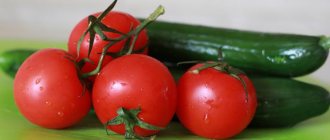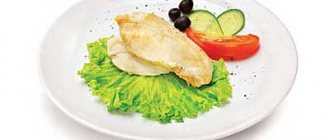Bell peppers can be found on any gardener’s plot. This is a very tasty and healthy product. And besides, it’s easy to grow. This vegetable is included in many dishes. It is boiled, stewed, fried, stuffed, and canned for the winter. Today a healthy lifestyle is becoming fashionable. People who want to lose weight are wondering if they can eat sweet peppers. To understand this, you need to know how many calories are in bell peppers and how to use them so as not to gain weight. This article will talk about this.
What are the benefits of pepper?
Before determining how many kcal there are in bell peppers, let’s consider the description of this product and how it is useful. There are many different varieties of this vegetable. They differ in shape, color, taste. There are brown, red, orange, yellow, and purple peppers.
Not everyone knows how many calories are in bell peppers, but many people know about the benefits of this product. Those who suffer include it in their diet:
- Anemia.
- Vascular diseases.
- Hypertension.
- Dermatitis.
- Swelling.
- Diabetes mellitus.
- Increased blood clotting.
- Depression.
- Poor appetite.
- Loss of strength.
By regularly consuming fresh or processed pepper, after a while a person’s condition improves.
This vegetable is especially indicated for pregnant women and the elderly.
Chemical composition of the vegetable
Considering its composition, bell pepper can be called a unique vegetable:
| Vitamins, macro- and microelements | Main beneficial properties |
| Retinol | Good for vision, is a good antioxidant. |
| A nicotinic acid | Supports proper functioning of the heart and blood vessels, regulates cholesterol levels in the blood. |
| Ascorbic acid | Increases the body's defenses. |
| B vitamins | Regulate the functioning of the nervous system, have a beneficial effect on memory, and increase stress resistance. |
| Tocopherol | Promotes rejuvenation and stimulates tissue regeneration. |
| Phylloquinone | Regulates the process of blood clotting, promotes bone tissue restoration and participates in calcium metabolism. |
| Beta carotene | One of the most powerful antioxidants. Has a beneficial effect on the visual system and immunity. |
| Potassium | Removes excess salt, prevents the development of sclerosis. |
| Calcium | Plays an important role in the transmission of nerve impulses and is an integral part of bone tissue. |
| Phosphorus | Useful for the proper functioning of cells. |
| Magnesium | Involved in the distribution of calcium and participates in the formation of bone tissue, supports the functioning of the heart and blood vessels. |
| Sodium | Takes part in the transmission of nerve impulses. |
| Iron | It is an important substance for maintaining the level of hemoglobin in the blood and takes part in gas exchange processes taking place in cells. |
| Copper | Participates in the production of red blood cells, helps maintain stable functioning of the immune system. |
| Manganese | Regulates blood glucose levels. |
| Selenium | Good for the myocardium. |
| Zinc | Increases the body's protective functions and accelerates tissue regeneration. |
Bell pepper has several varieties; the actual presence of certain substances may differ from the list presented. This also changes the calorie content of the product slightly.
How many calories does pepper have?
On average, the calorie content of bell pepper per 100 grams is about 25 kcal. Therefore, this product can safely be classified as dietary. For those who are on a diet, it is useful to include such a vegetable in their daily diet.
Everyone knows that peppers come in different colors. The question arises: is the calorie content of fresh red bell pepper per 100 grams different from yellow or green, for example? Here it is worth saying that orange, red, yellow, green are the fruit of the same bush. The color depends on the time of planting and ripeness.
Green peppers have lower sugar content. Therefore, it is considered to be the lowest in calories. It tastes somewhat bitter. But red fruits contain much more sugar. Therefore, the calorie content of fresh bell pepper will be higher by 100 grams. Many people love red or orange peppers because they are sweeter. But dieters should give preference to green varieties of this healthy product.
Let's consider the energy value of green and red specimens. So, there are about 20 calories in a green vegetable. Closer to 29-32 - that’s how many calories a red bell pepper contains. This indicator is determined per 100 grams of product.
Yellow pepper is also worth considering. So, the calorie content of yellow bell pepper is about 27 kcal. This vegetable contains a lot of ascorbic acid and carotene. It, like chocolate, promotes the production of endorphins. But unlike sweets, it does not contribute to gaining extra pounds.
It is best to eat the vegetable raw. For example, add it to a salad. Due to the low calorie content of this product, even after undergoing heat treatment, it will not bring much harm to those who are watching their figure. For example, after stewing, the calories in bell peppers will not exceed 30.
Below are some interesting facts about sweet peppers:
- Compared to green vegetables, red vegetables contain almost 11 times more beta-carotene and 1.5 times more vitamin C.
- Scientists have proven that roasted vegetables provide the greatest taste and retain all nutrients.
- Green peppers are harvested earlier than yellow or red ones. The main thing is not to miss the moment when the green fruits begin to ripen and acquire a warmer shade.
- Depending on the cooking method, calorie content tends to vary.
Below is the energy value of the product depending on the type of processing:
- Boiled – 29 kcal.
- Fried - about 201 kcal.
- The canned product contains 24 kcal.
- Grilled peppers have 34 kcal.
- Marinated – 65 kcal.
- Baked in the oven contains about 65 kcal.
Low-calorie recipes with bell peppers
The vegetable is a common ingredient in many low-calorie cooking dishes that will help get your body in shape.
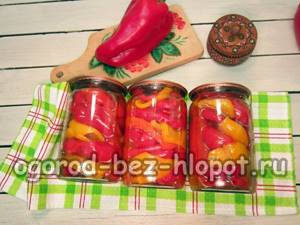
You may be interested in:
Canned peppers without sterilization for the winter Preserving sweet peppers for the winter in this way will take a minimum of time and effort, since it is done without...Read more...
Cream soup
Cream soup based on fried peppers is a tender and tasty dish that satisfies your appetite and does not contribute to weight gain.
To prepare it you need to take:
- Broth (chicken) – 1 l.
- Sweet red pepper – 4 pcs.
- Cauliflower – 1 pc.
- Onions – 1 pc.
- Coarsely ground chili – ½ tsp.
- Paprika – 1 tsp. l.
- Garlic – 1-2 cloves.
- Vegetable oil – 1 tbsp. l.
- Thyme – 1 tsp. l.
- Cheese (goat) – 100 g.
- Spices - to taste.
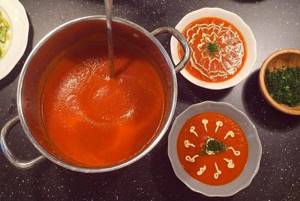
Before you start frying the peppers, you need to wash them, cut them in half and remove the seeds. Vegetables are fried in hot oil for 10 minutes on the inside. Place the fried vegetables in an airtight container for 20 minutes, after which they must be peeled and cut into cubes.
Cauliflower, disassembled into inflorescences, is baked in the oven for half an hour at 200°. At this time, fry the diced onion until soft. Then chopped garlic, thyme and chili are added to it. Next, pepper, cabbage, paprika, broth, goat cheese and spices are added to the mixture. The soup is boiled for 10 minutes, after which it is brought in a blender to a creamy consistency.
Stuffed pepper
This dish is widely popular all over the world.
Ingredients:
- Pepper – 3 pcs.
- Rice – 150 g.
- Minced meat – 300 g.
- Onion – 1 pc.
- Garlic – 2 cloves.
- Paprika – 1 pinch.
- Spices - to taste.
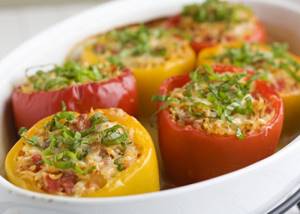
To prepare the filling, boil the rice and fry the finely chopped onion and garlic until soft. Minced meat and paprika are added to the onion and fried for 10 minutes. Then rice is added to the minced meat, and the resulting mixture is simmered in a frying pan for a few more minutes. Next, spices are added.
The peppers, from which the tops have been previously removed and the seeds removed, are stuffed with minced meat. The stuffed vegetables are laid out on a baking dish, at the bottom of which it is recommended to pour a little water. Peppers are baked for 15 minutes at a temperature of 220°.
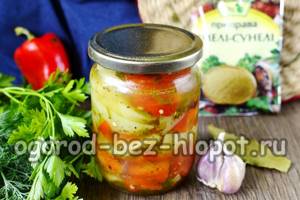
You may be interested in:
Georgian bell pepper appetizer, tasty and simple Try an interesting version of Georgian pepper appetizer, prepared for the winter. Cooking strictly according to the recipe with...Read more...
Roasted Pepper Salad
A warm salad will not only satisfy your hunger, but will also delight you with its bright colors.
The salad includes:
- Sweet pepper – 3 pcs.
- Red onion – ½ pc.
- Parsley - to taste.
- Olive oil – 2 tbsp. l.
- Wine vinegar - ½ tbsp. l.
- Capers - 2 tbsp. l.
- Salt - to taste.

The vegetable is peeled, cut into 6 pieces and lightly sprinkled with oil. Then it is laid out on a baking sheet and baked in the oven until soft. The finished pepper is cut into strips and mixed with chopped onions, capers and parsley. The salad is dressed with olive oil and vinegar.
Vegetable rolls
A simple and tasty dish, all you need to prepare is:
- 3 sweet peppers;
- 200 g cream cheese;
- 30 ml olive oil;
- spices.

Vegetables cut in half, without veins or seeds, are baked in the oven for 15 minutes at 200°. Place the baked peppers in an airtight container for 10 minutes, after which the skins are removed. Cream cheese is mixed with the rest of the ingredients and spread on vegetables, cut into strips, after which they are rolled into rolls and secured with skewers.
Nutritional value of sweet pepper
It is clear that raw red sweet pepper is a low-calorie, dietary vegetable. But what is the nutritional value of bell pepper remains to be figured out. This vegetable is characterized by a rich composition. It contains a lot of vitamins, microelements and other useful substances.
It is rich in vitamins A, K, B, C, E and P. If you compare peppers with currants or lemon, you can see that they contain much more vitamin C. In terms of vitamin A content, sweet peppers are not inferior to carrots. The product is not deprived of minerals either. So, it contains quite a lot of phosphorus, potassium, iodine, and calcium. There is also fluorine, manganese and sodium.
The nutritional value of bell pepper - bzhu (proteins/fats/carbohydrates) is given below:
- Carbohydrates contain 82%.
- Proteins about 15%.
- Fats make up only 3%.
Dietary fiber is also present in the pulp. They are about 5% of the body's daily needs. There is also water. About 3.5%.
Table of proteins, fats, carbohydrates in different types of peppers
Proteins, fats and carbohydrates (hereinafter referred to as BJU) are substances that are necessary to maintain the vital functions of the human body. A lack of one of these compounds can lead to serious diseases and pathological processes in the body.
Capsicum, like most products of plant origin, contains a balanced amount of dietary fatty acids, which makes it not only tasty, but also a healthy food product. People on a diet, as a rule, do not have enough calories and dietary fat, respectively, so it is especially useful for them to introduce this vegetable into their diet. The product will help replenish nutritional deficiencies in the body without harming your figure.
A small amount of calories in combination with a useful chemical composition and a balanced content of BJU allows the product to be used in dietary nutrition. A vegetable present in your daily diet will speed up the process of losing weight without stressing the body. It is pepper that is most often used in express diets, which help to lose several kilograms in a short time.
How to use pepper?
To saturate the body with a daily dose of all nutrients, it is recommended to consume 1-2 bell pepper fruits.
This product is used not only as an ingredient in delicious, healthy salads, but also made into vegetable juice. Some people use pepper for cosmetic purposes. Vitamin masks are prepared from the pulp, which improve the condition of facial skin.
However, it should be remembered that this product is not suitable for everyone. For example, experts do not advise those who have epilepsy, hemorrhoids, or colitis to eat sweet peppers. For kidney and liver diseases in the acute stage, it is also better to exclude it from the daily menu.
Thus, bell pepper, the nutritional value and calorie content of which were discussed in this article, is a healthy and dietary product. The diet of those losing weight must include such a vegetable. It will not harm your figure and will saturate the body with all the necessary vitamins and minerals. Read the article: Bell pepper seeds: the best varieties and cultivation characteristics.
Dried
Large and fleshy sweet fruits of red varieties serve as the basis for the production of a popular spice called paprika. To obtain the powder, they are first cleared of the core and seeds, then the pulp is dried and ground or ground. The result is a delicious spice of bright color with a pronounced pepper aroma and a warm, sweetish taste. Paprika is also made from slightly hot red pods, which gives it a spicy taste. But for lovers of sweet spices, an absolutely non-hot, pleasant-tasting, semi-sweet seasoning, which is easy to recognize by the characteristic shine of a rich red powder, is ideal.

The calorie content of bell pepper, dried and ground into paprika, is 358 kcal/100 g. Therefore, lovers of this spice who want to maintain a slim figure need to consume it in moderation. In addition, this spice is actively used in some national cuisines, in particular Mexican, Hungarian, Mediterranean, Greek, Spanish, German, Italian, Indian and Chinese. The aromatic powder is added to almost all sauces, meat, first, vegetable and many other dishes, which significantly increases their calorie content. This should be taken into account when eating in cafes and restaurants to avoid consuming a fairly large number of hidden calories.
Regular moderate inclusion of sweet dried paprika in the diet has a beneficial effect on the body:
- improves the condition of the circulatory system;
- prevents the formation of blood clots;
- accelerates digestion processes;
- prevents colds.
It is not recommended to use dried paprika if you are hypersensitive or have diseases of the liver, kidneys, pancreas and stomach.





